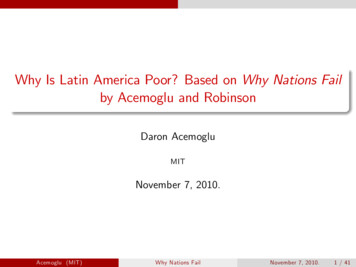
Transcription
Why You Should Never Use the Hodrick-Prescott Filter James D. Hamiltonjhamilton@ucsd.eduDepartment of Economics, UC San DiegoJuly 30, 2016Revised: May 13, 2017ABSTRACTHere’s why. (1) The HP filter produces series with spurious dynamic relations that have nobasis in the underlying data-generating process. (2) Filtered values at the end of the sample arevery different from those in the middle, and are also characterized by spurious dynamics. (3) Astatistical formalization of the problem typically produces values for the smoothing parametervastly at odds with common practice, e.g., a value for λ far below 1600 for quarterly data. (4)There’s a better alternative. A regression of the variable at date t h on the four most recentvalues as of date t offers a robust approach to detrending that achieves all the objectives soughtby users of the HP filter with none of its ——— I thank Daniel Leff for outstanding research assistance on this project and Frank Diebold,Robert King, James Morley, and anonymous referees for helpful comments on an earlier draft ofthis paper .
1Introduction.Often economic researchers have a theory that is specified in terms of a stationary environment,and wish to relate the theory to observed nonstationary data without modeling the nonstationarity. Hodrick and Prescott (1981, 1997) proposed a very popular method for doing this, commonlyinterpreted as decomposing an observed variable into trend and cycle. Although drawbacks totheir approach have been known for some time, the method continues today to be very widelyadopted in academic research, policy studies, and analysis by private-sector economists.Forthis reason it seems useful to collect and expand on those earlier concerns here and note thatthere is a better way to solve this problem.2Characterizations of the Hodrick-Prescott filter.Given T observations on a variable yt , Hodrick and Prescott (1981, 1997) proposed interpretingthe trend component gt as a very smooth series that does not differ too much from the observedy t .1It is calculated asmin{gt }Tt 1nPT2t 1 (yt gt ) λo2.[(g g) (g g)]tt 1t 1t 2t 1PT(1)When the smoothness penalty λ 0, gt would just be the series yt itself, whereas when λ the procedure amounts to a regression on a linear time trend (that is, produces a series whosesecond difference is exactly 0). The common practice is to use a value of λ 1600 for quarterlytime series.1Phillips and Jin (2015) reviewed the rich prior history of generalizations of this approach.1
A closed-form expression for the resulting series can be written in vector notation by definingT̃ T 2,y (yT , yT 1 , ., y1 )0 , g(T 1) (gT , gT 1 , ., g 1 )0 and(T̃ 1)"H #IT(T T )(T T̃ )0(T 2) Q (T T̃ ) 1 20 ···1 2 101.00000000000 ··· 00 0 . . ··· . . . · · · 2 1 0 · · · 1 2 1The solution to (1) is then given by2g (H 0 H λQ0 Q) 1 H 0 y A y.(2)The inferred trend gt for any date t is thus a linear function of the full set of observations on yfor all dates.As noted by Hodrick and Prescott (1981) and King and Rebelo (1993), the identical inferencecan alternatively be motivated from particular assumptions about the time-series behavior of thetrend and cycle components. Suppose our goal was to choose a value for a (T 1) vector atsuch that the estimate g̃t a0t y has minimum expected squared difference from the true trend:minE(gt a0t y)2 .at2The appendix provides a derivation of equations (2) and (4).further details on A and a convenient algorithm for calculating it.2(3)Cornea-Madeira (forthcoming) provided
The solution to this problem is the population analog to a sample regression coefficient, and isa function of the variance of y and its covariance with g: 1g̃ E(gy 0 ) [E(yy 0 )]y Ãy.(4)As an example of a particular set of assumptions we might make about these covariances, let ctdenote the cyclical component and vt the second difference of the trend component:yt gt ct(5)gt 2gt 1 gt 2 vt .(6)Suppose that we believed that vt and ct are uncorrelated white noise processes that are alsouncorrelated with (g0 , g 1 ), and let C0 denote the (2 2) variance of (g0 , g 1 ). These assumptionsimply a particular value for à in (4). As we let the variance of (g0 , g 1 ) become arbitrarily large(represented as C0 1 0), then in every sample the inference (4) would be numerically identicalto expression (2).Proposition 1. For λ σ 2c /σ 2v and any fixed T, under conditions (5)-(6) with ct and vtwhite noise uncorrelated with each other and uncorrelated with (g0 , g 1 ), the matrix à in (4)converges to the matrix A in (2) as C0 1 0.The proposition establishes that if researcher 1 sought to identify a trend by solving theminimization problem (1) while researcher 2 found the optimal linear estimate of a trend processthat was assumed to be characterized by the particular assumption that vt and ct were bothwhite noise, the two researchers would arrive at the numerically identical series for trend andcycle provided the ratio of σ 2c to σ 2v assumed by researcher 2 was identical to the value of λ usedby researcher 1.3
The Kalman smoother is an iterative algorithm for calculating the population linear projection (4) for models where the variance and covariance can be characterized by some recursivestructure.3In this case, (5) is the observation equation and (6) is the state equation. Thusas noted by Hodrick and Prescott, applying the Kalman smoother to the above state-spacemodel starting from a very large initial variance for (g0 , g 1 )0 offers a convenient algorithm forcalculating the HP filter, and is in fact a way that the HP filter is often calculated in practice.Nevertheless, this observation should also be a bit troubling for users of the HP filter, in thatthey never defend the claim that the particular structure assumed in Proposition 1 is an accuraterepresentation of the true data-generating process. Indeed, if a researcher did know for certainthat these equations were the true data-generating process, and further knew for certain thevalue of the population parameter λ σ 2c /σ 2v , he would probably be unhappy with using (2) toseparate cycle from trend! The reason is that if this state-space structure was the true DGP,the resulting estimate of the cyclical component ct yt g̃t would be white noise– it wouldbe random and exhibit no discernible patterns.By contrast, users of the HP filter hope tosee suggestive patterns in plots of the series that is supposed to be interpreted as the cyclicalcomponent of yt .Premultiplying (2) by H 0 H λQ0 Q gives a system of equations whose tth element is[1 λ(1 L 1 )2 (1 L)2 ]gt ytfor t 1, 2, ., T 2(7)for L the lag operator (Lk xt xt k , L k xt xt k ). In other words, F (L)gt yt forF (L) 1 λ(1 L 1 )2 (1 L)2 .3See for example Hamilton, 1994, equation [13.6.3].4(8)
The following proposition establishes some properties of this filter.4Proposition 2. For any λ : 0 λ , the inverse of the operator (8) can be written 1[F (L)] 1 (φ21 /4)L1 (φ21 /4)L 1 C 11 φ1 L φ2 L2 1 φ1 L 1 φ2 L 2 (9)whereP1jj j 0 R [cos(mj) cot(m) sin(mj)]z21 φ1 z φ2 z11 φ1z 1 φ2z 2 P j 0(10)Rj [cos(mj) cot(m) sin(mj)]z jφ1 (1 φ2 ) 4φ2(11)(1 φ1 φ2 )2 φ2 /λ(12)C φ2λ(1 φ22 φ31 /2)pR φ2φ21cos(m) φ1 /(2R).(13)(14)Roots of (1 φ1 z φ2 z 2 ) 0 are complex and outside the unit circle, φ1 is a real number between0 and 2, φ2 a real number between 1 and 0, and R a real number between 0 and 1.Figure 1 plots the values of φ1 and φ2 generated by different values of λ. For λ 1600,φ1 1.777 and φ2 0.7994. These imply R 0.8941, so that the absolute value of theweights decay with a half-life of about 6 quarters while R60 0.0012.54Related results have been developed by Singleton (1988), King and Rebelo (1989, 1993), Cogley and Nason(1995), and McElroy (2008). Unlike these papers, here I provide simple direct expressions for the values of φ1and φ2 , and my analytical expressions of the HP filter entirely in terms of real parameters in (9) and (10) appearto be new.5The other parameters for this case are C 0.056075, m 0.111687 and cot(m) 8.9164.5
Expression (7) means that for t more than 15 years from the start or end of a sample ofquarterly data, the cyclical component ct yt gt is well approximated byct λ(1 L 1 )2 (1 L)2 gt λ(1 L 1 )2 (1 L)2λ(1 L)4yt yt 2 .F (L)F (L)(15)As noted by King and Rebelo, obtaining the cyclical component for these observations thusamounts to taking fourth differences of the original yt 2 and applying the operator [F (L)] 1 tothe result, so that the HP cycle might be expected to produce a stationary series as long asfourth-differences of the original series are stationary. However, De Jong and Sakarya (2016)noted there could still be significant nonstationarity coming from observations near the start orend of the sample, and Phillips and Jin (2015) concluded that for commonly encountered samplesizes, the HP filter may not successfully remove the trend even if the true series is only I(1).33.1Drawbacks to the HP filter.Appropriateness for typical economic time series.The presumption by users of the HP filter is that it offers a reasonable approach to detrendingfor a range of commonly encountered economic time series. The leading example of a time-seriesprocess for which we would want to be particularly convinced of the procedure’s appropriatenesswould be a random walk. Simple economic theory suggests that variables such as stock prices(Fama, 1965), futures prices (Samuelson, 1965), long-term interest rates (Sargent, 1976; Pesando,1979), oil prices (Hamilton, 2009), consumption spending (Hall, 1978), inflation, tax rates, andmoney supply growth rates (Mankiw, 1987) should all follow martingales or near martingales. Tobe sure, hundreds of studies have claimed to find evidence of statistically detectable departuresfrom pure martingale behavior in all these series. Even so, there is indisputable evidence that6
a random walk is often extremely hard to beat in out-of-sample forecasting comparisons, as hasbeen found for example by Meese and Rogoff (1983) and Cheung, Chinn, and Pascual (2005)for exchange rates, Flood and Rose (2010) for stock prices, Atkeson and Ohanian (2001) forinflation, or Balcilar, et al. (2015) for GDP, among many others.Certainly if we are notcomfortable with the consequences of applying the HP filter to a random walk, then we shouldnot be using it as an all-purpose approach to economic time series.For yt yt 1 εt , where εt is white noise and (1 L)yt εt , Cogley and Nason (1995)6 notedthat expression (15) means that when the HP filter is applied to a random walk, the cyclicalcomponent for observations near the middle of the sample will approximately be characterizedbyct λ(1 L)3εt 2 .F (L)For λ 1600 this isonPj(0.8941)[cos(0.1117j) 8.916sin(0.1117j)](q q)ct 89.72 q0,t 2 1,t 2 j2,t 2 jj 0with q0t εt 3εt 1 3εt 2 εt 3 , q1t εt 3.79εt 1 5.37εt 2 3.37εt 3 0.79εt 4 ), 7 andq2t 0.79εt 1 3.37εt 5.37εt 1 3.79εt 2 εt 3 . The underlying innovations εt are completelyrandom and exhibit no patterns, whereas the series ct is both highly predictable (as a result ofthe dependence on lags of εt j ) and will in turn predict the future (as a result of dependenceon future values of εt j ). Since the coefficients that make up [F (L)] 1 are determined solely bythe value of λ, these patterns in the cyclical component are entirely a feature of having applied6Harvey and Jaeger (1993) also have a related discussion.7The term q1t is the expansion of (1 L)3 [1 (φ21 /4)L]εt .7
the HP filter to the data rather than reflecting any true dynamics of the data-generating processitself.For example, consider the behavior of stock prices and real consumption spending.8Thetop panels of Figure 2 show the autocorrelation functions for first-differences of these series,confirming that there is little ability to predict either from its own past values, as we mighthave expected from the literature cited at the start of this section. The lower panels show crosscorrelations. Consumption has no predictive power for stocks, though stock prices may have amodest ability to anticipate changes in aggregate consumption.Figure 3 shows the analogous results if we tried to remove the trend by HP filtering ratherthan first-differencing. The HP cyclical components of stock prices and consumption are bothextremely predictable from their own lagged values as well as each other. The rich dynamics inthese series are purely an artifact of the filter itself and tell us nothing about the underlying datagenerating process. Filtering takes us from the very clean understanding of the true propertiesof these series that we can easily see in Figure 2 to the artificial set of relations that appear inFigure 3. The values plotted in Figure 3 summarize the filter, not the data.3.2Properties of the one-sided HP filter.The HP trend and cycle have an artificial ability to “predict” the future because they are byconstruction a function of future realizations. One way we might try to get around this wouldbe to restrict the minimization problem in (3), forcing at to load only on values (yt , yt 1 , ., y1 )08Stock prices were measured as 100 times the natural log of the end-of-quarter value for the S&P 500 andconsumption from 100 times the natural log of real personal consumption expenditures from the U.S. NIPAaccounts. All data for this figure are quarterly for the period 1950:1 to 2016:1.8
that have been observed as of date t, rather than also using future values as was done in the HPfilter (4). The value of this one-sided projection for date t could be calculated by taking theend-of-sample HP-filtered series for a sample ending at t, repeated for each t.9The top panel of Figure 4 shows the result
30.07.2016 · 3.1 Appropriateness for typical economic time series. The presumption by users of the HP lter is that it o ers a reasonable approach to detrending for a range of commonly encountered economic time series. The leading example of a time-series process for which we would want to be particularly convinced of the procedure’s appropriateness would be a random walk. Simple economic theory











